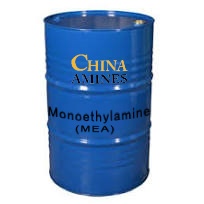Your Questions and Comments
Your sales and customer service desk partners within China Amines Co will continue to serve you. You can also contact us via our headquarter office-
Email:info@chinaamines.com
China Amines Co
Product Profile
1. Chemical Structure and Properties
Molecular Formula:
C₂H₇NO
Structural Formula:
HOCH₂CH₂NH₂ – A primary amine with both hydroxyl (-OH) and amino (-NH₂) functional groups.
Physical Properties:
- Appearance: Colorless to pale yellow viscous liquid with an ammonia-like odor.
- Boiling Point: 170°C
- Density: 1.01 g/cm³
- Viscosity: 24 mPa·s at 20°C
- Solubility: Fully miscible with water, ethanol, and polar solvents; hygroscopic.
Chemical Properties:
- Basicity: Weak base (pKa = 9.5), reacts with acids to form salts (e.g., MEA hydrochloride).
- Reactivity: Undergoes esterification, alkylation, and chelation; thermally stable up to 140°C.
2. Industrial Applications
Gas Treatment:
- Acid Gas Removal: Widely used in amine scrubbing to capture CO₂ and H₂S from natural gas and flue gas (e.g., Shell’s ADIP-X process).
- Efficiency: Achieves 90% CO₂ capture at 40–60°C with 30% MEA solution.
Personal Care:
- Surfactant Synthesis: Intermediate for cocamide MEA and lauramide MEA in shampoos and lotions.
Agrochemicals:
- Herbicide Production: Key component in glyphosate formulations (e.g., Monsanto’s Roundup®).
Pharmaceuticals:
- Drug Intermediate: Used in synthesizing antihistamines (e.g., diphenhydramine).
Textiles:
- pH Adjuster: Neutralizes acidic dyes in wool and silk processing.
3. Safety and Toxicology
Health Hazards:
- Skin/Eye Contact: Severe irritation and burns (rabbit skin LD50: 2,000 mg/kg).
- Inhalation (≥10 ppm): Respiratory tract irritation, pulmonary edema (LC50 rat, 4h: 2,000 ppm).
- Ingestion: Moderately toxic (oral LD50 rat: 2,000 mg/kg); causes gastrointestinal damage.
Acute Exposure:
- Chronic Effects: Potential liver/kidney toxicity and sensitization (allergic dermatitis).
Flammability:
- Combustible liquid (flash point: 93°C; autoignition temperature: 410°C).
Protection Measures:
- PPE: Nitrile gloves, goggles, and respirators for vapor control.
- First Aid: Flush affected areas with water for 15+ minutes; seek medical attention.
4. Environmental and Regulatory Compliance
Environmental Impact:
- Aquatic Toxicity: LC50 (fish, 96h): 1,000 mg/L; EC50 (daphnia): 800 mg/L.
- Biodegradability: Readily biodegradable (OECD 301B: >90% in 28 days).
- Atmospheric Fate: Reacts with hydroxyl radicals (half-life ~1 day).
Regulatory Frameworks:
- EU: CLP Regulation: Skin Corr. 1B (H314), Eye Dam. 1 (H318).
- USA: OSHA PEL: 3 ppm (8-hour TWA); EPA TRI reporting required.
- China: GB 13690-2009: Classified as Class 8.2 Corrosive Substance.
Transport:
UN Number: UN 2491; Hazard Class: 8 (Corrosive), Packing Group III.
5. Case Studies and Application Insights
Case 1: CO₂ Capture in Power Plants
Process: MEA-based scrubbing at Boundary Dam Power Station (Canada) captures 1 million tons of CO₂ annually.
Challenges: High energy demand for solvent regeneration (3–4 GJ/ton CO₂).
Case 2: Personal Care Formulations
Application: L’Oréal uses cocamide MEA in Garnier Fructis® shampoos for foam stabilization.
Performance: Enhances lather density by 30% vs. sulfate-free alternatives.
Comparative Analysis:
- Pros: MEA has higher CO₂ absorption capacity (0.5 mol CO₂/mol amine vs. 0.3 for DEA).
- Cons: MEA degrades faster under oxidative conditions, requiring frequent solvent replacement.


